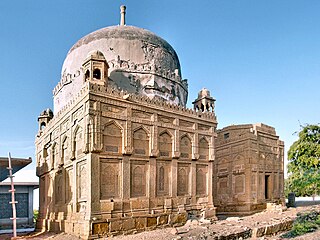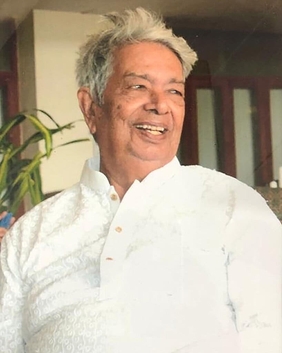
The Mukhi House also known as Mukhi Mahal is a museum located in Hyderabad, Sindh, Pakistan. [1] For a brief period, it housed a government school named Khadija Girls School. [2]

The Mukhi House also known as Mukhi Mahal is a museum located in Hyderabad, Sindh, Pakistan. [1] For a brief period, it housed a government school named Khadija Girls School. [2]
Built in 1920 by Jethanand Mukhi, the Mukhi House in Hyderabad served as a family residence until the partition of India compelled the family to vacate by 1957. [2]
Following the partition of India, the property's stewardship transitioned several times, including possession by the Evacuee Trust Property Board and various government bodies. [2] The property endured further harm due to misuse and civil disturbances. [2] The Sindh Antiquities Department initiated restoration work in 2009, with the Mukhi family endorsing the property's conversion into a public museum. [2]
It was once visited by the former prime minister of India, Jawaharlal Nehru, and other personalities of the subcontinent. [1]
Led by Kaleemullah Lashari, the restoration team collaborated with the Mukhi family for an accurate representation of the original interior design. [2] In 2020, the Mukhi House was opened for the public as an archaeological museum after restoration of the building's disfigured glory. [3] [4] [5]
The house exhibits a blend of Renaissance, Art Deco, and Art Nouveau architectural styles, and houses several bedrooms, courtyards, halls, and a library. [2]
Craftsmanship from India is evident in the floor work, wooden details, and fresco-like stonework. [2] Exhibits within the museum, including family photographs and artifacts, showcase the Mukhi family's affluent lifestyle and their social and political prominence. [2]

Sindh is a province of Pakistan. Located in the southeastern region of the country, Sindh is the third-largest province of Pakistan by land area and the second-largest province by population after Punjab. It is bordered by the Pakistani provinces of Balochistan to the west and north-west and Punjab to the north. It shares an International border with the Indian states of Gujarat and Rajasthan to the east; it is also bounded by the Arabian Sea to the south. Sindh's landscape consists mostly of alluvial plains flanking the Indus River, the Thar Desert in the eastern portion of the province along the international border with India, and the Kirthar Mountains in the western portion of the province.

The Partition of India in 1947 was the change of political borders and the division of other assets that accompanied the dissolution of the British Raj in the Indian subcontinent and the creation of two independent dominions in South Asia: India and Pakistan. The Dominion of India is today the Republic of India, and the Dominion of Pakistan—which at the time comprised two regions lying on either side of India—is now the Islamic Republic of Pakistan and the People's Republic of Bangladesh. The partition was outlined in the Indian Independence Act 1947. The change of political borders notably included the division of two provinces of British India, Bengal and Punjab. The majority Muslim districts in these provinces were awarded to Pakistan and the majority non-Muslim to India. The other assets that were divided included the British Indian Army, the Royal Indian Navy, the Royal Indian Air Force, the Indian Civil Service, the railways, and the central treasury. Provisions for self-governing independent Pakistan and India legally came into existence at midnight on 14 and 15 August 1947 respectively.

Sindhis are an Indo-Aryan ethnolinguistic group who speak the Sindhi language and are native to the Pakistani province of Sindh. The historical homeland of Sindhis is bordered by the southeastern part of Balochistan, the Bahawalpur region of Punjab and the Kutch region of Gujarat. Having been isolated throughout history unlike its neighbours, Sindhi culture has preserved its own uniqueness.

Sukkur is a city in the Pakistani province of Sindh along the western bank of the Indus River, directly across from the historic city of Rohri. Sukkur is the third largest city in Sindh after Karachi and Hyderabad, and 14th largest city of Pakistan by population. New Sukkur was established during the British era alongside the village of Sukkur. Sukkur's hill, along with the hill on the river island of Bukkur, form what is sometimes considered the "Gate of Sindh".

Mirpur Khas is the capital city of the Mirpur Khas District and Mirpur Khas Division in the Sindh province, Pakistan. Mirpur Khas is the 6th largest city in Sindh province and the 34th largest city of Pakistan. The city was built by Talpur rulers of Mankani branch. According to the 2017 Census of Pakistan, its population is 233,916. Mirpur Khas is known for its mango cultivation, with hundreds of varieties of the fruit produced each year - it is also called the “City of Mangoes,” and has been home to an annual mango festival since 1955. After the completion of Hyderabad-Mirpurkhas dual carriage way, the city has become hub of commercial activities.

The Lahore Museum is a museum located in Lahore, Punjab, Pakistan. Founded in 1865 at a smaller location and opened in 1894 at its current location on The Mall in Lahore during the British colonial period, Lahore Museum is Pakistan's largest museum, as well as one of its most visited ones.

The Mohatta Palace is a museum located in Karachi, Sindh, Pakistan. Designed by Ahmed Hussain Agha, the palace was built in 1927 in the posh seaside locale of Clifton as the summer home of Shivratan Mohatta, a Hindu Marwari businessman from what is now the modern-day Indian state of Rajasthan. The palace was built in the tradition of stone palaces of Rajasthan, using pink Jodhpur stone in combination with the local yellow stone from nearby Gizri. Mohatta could enjoy this building for only about two decades before the partition of India, after which he left Karachi for the new state of India.

The Sindhudesh Movement is a separatist movement, based in Sindh, Pakistan, seeking to create a homeland for Sindhis by establishing an ethnic state called Sindhudesh, which would be either autonomous within Pakistan or independent from it.
Hirabad is one of the oldest parts of the city of Hyderabad in Sindh, Pakistan. Before partition in 1947, Hirabad was a thriving township of wealthy Hindu Sindwork merchants and traders who generally belonged to the Amil and Bhaiband castes of Hindu Lohanas.
The Aga Khan Trust for Culture (AKTC) is an agency of the Aga Khan Development Network (AKDN), a family of institutions created by Aga Khan IV with distinct but complementary mandates to improve the welfare and prospects of people in the developing world, particularly in Asia and Africa. It focuses on the revitalization of communities in the Muslim world—physical, social, cultural, and economic. The AKTC was founded in 1988 and is registered in Geneva, Switzerland, as a private non-denominational philanthropic foundation.

Husri is a town and union council of Hyderabad District in the Sindh province of Pakistan. It is part of the rural Taluka of Hyderabad and is located at 25°19'0N 68°25'0E and lies to the south-east of the capital, Hyderabad. Husri is situated near Bihar Colony, a well-known larger housing society. Husri plays an important role in Hyderabad's and to a certain extent, Sindh's politics. A recent study concluded through internal information gathered by elderly residents of the town proposed that this town is known to be over 100 years old. Husri involves locals that are a part of the 'Sindh' proclaimed as villagers that are one of the most marginalized groups in the region and part of the country's agricultural sector in Interior Sindh. Besides, after the 1947 Partition, the majority of India remained stranded, leading to the migration of locals from Bihar District of India and numerous Hindus occupied portion of land for residency. They are still situated within the local town, near the nearby streamline of water originating from Indus River in abundance. The population variety is observable due to presence of Muhajirs, Sindhis, Biharis, Hindus, and other respective groups co-exist. Husri villagers, religious preachers, shopkeepers, businessmen, landlords, social workers, students all have a long and proud history and play an important role in Husri's cultural heritage. This micro city has a widespread abundance of garments, toys etc. Various politicians from Sindh visit this diversified town. It is widely known for its politics. Most of the town supports PPP. In Pakistan, figures indicate that intake of vitamin-rich foods is a challenge for many people. As compared to Hyderabad food, often in towns/urban areas such as Husri Union Council, the local diets are inadequate in terms of nutrient consumption, which eventually leads to undernutrition contributing to the decline of cognitive skills in the long run. However, the upper-class sector of peoples & financially equipped locals within the region can often visit Hyderabad to purchase groceries, re-fill food/pharmaceutical stocks back in the town, buy furniture & building materials, etc. to enhance the living standard of Husri.

Institute of Sindhology is a resource for knowledge of the Sindh region in present-day Pakistan.

Pakko Qillo is a fort in Hyderabad, Sindh, Pakistan.

The Sindh Museum is a museum located in Hyderabad, Sindh, Pakistan. The museum was established in 1971 to collect, preserve, study, and exhibit the records of the cultural history of Sindh. It also sometimes hosts cultural fairs.
Sindhis in India refer to a socio-ethnic group of people living in the Republic of India, originating from Sindh. After the 1947 Partition of India into the dominions of new Muslim-majority Pakistan and remaining Hindu-majority India, a million non-Muslim Sindhis migrated to independent India. As per the 2011 census of India, there are 2,772,364 Sindhi speakers in the Indian Republic. However, this number does not include ethnic Sindhis who no longer speak the language.

Sadhu Thanwardas Lilaram Vaswani was an Indian educationist who started the Mira Movement In Education and set up St. Mira's School in Hyderabad, Sindh, and later moved to Pune after 1949. A museum, Darshan Museum dedicated to his life and teaching was opened in Pune, in 2011.

Orangi District is an administrative district of Karachi Division in Sindh, Pakistan.
Sindhi Americans are Americans or residents of the United States who are of Sindhi descent, originating from the Pakistani province of Sindh. They are a subgroup of Pakistani Americans or Indian Americans.

The Insurgency in Sindh is a low-intensity insurgency waged by Sindhi Nationalists against the government of Pakistan. Sindhi nationalists want to create an independent state called Sindhudesh.However, this movement never gained support from the populace of urban Sindh.

Suhail Zaheer Lari was a Pakistani historian and author who focused on research and documentation of the history of the Sindh region in Southern Pakistan. He was a co-founder of the Heritage Foundation of Pakistan, a conservation organization which sought to drive awareness to the region's art, architecture, and cultural heritage.